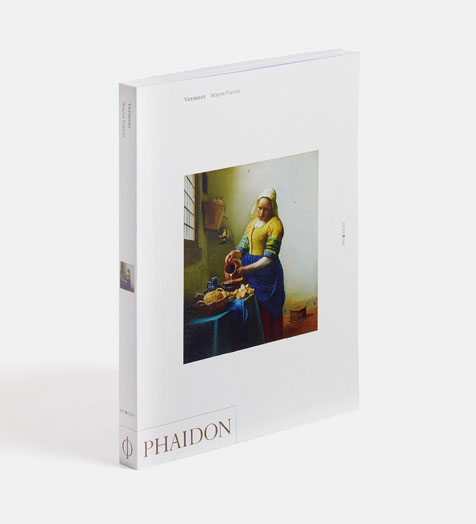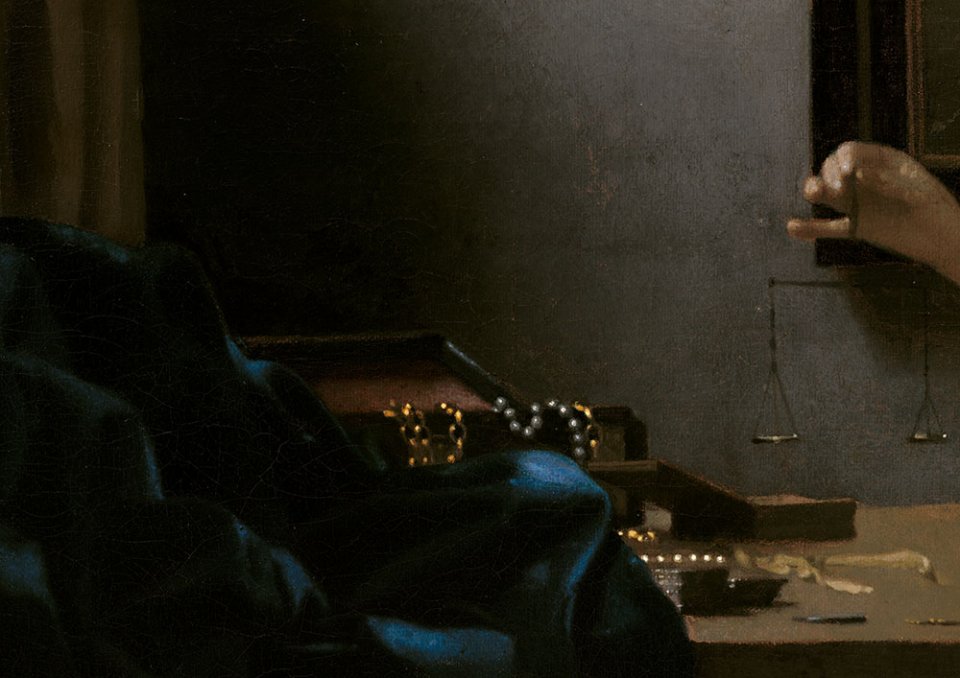Johannes Vermeer - paintings and new book
Getting Closer to Vermeer with Three New Books on the Artist

Johannes Vermeer, “The Milkmaid” (1658–61), Rijksmuseum, Amsterdam (photo courtesy Taschen)
Vermeer died twice. The first time was in 1675, after the Dutch art market collapsed. As his widow described, “Having no means of his own, he had lapsed into such decay and decadence […] as if he had fallen into a frenzy, in a day or day and a half he had gone from being healthy to being dead.” The second time was when history forgot him: shortly after his death, he disappeared from cultural memory.


‘Vermeer (Art and Ideas)’ by Wayne Franits (image courtesy Phaidon)
“The Music Lesson” (1662–64) entered the British Royal Collection in 1762 as a work by Frans van Mieris the Elder. “Young Woman with a Water Pitcher” (1662–65), at the Metropolitan Museum in New York, was once a highly praised Gabriël Metsu. A forged Pieter de Hooch signature on “The Art of Painting” (1662–68) increased the work’s value significantly, which is crushing, given the piece was made by Vermeer to show potential clients the extent of his skills. Even 200 years after the Delft artist’s death, a Pieter de Hooch work sold for 156,000 francs, and this two years after Vermeer’s “A Lady Seated at the Virginal” (1670–75) went for a mere 2,000 (78 times less).
Narratives within narratives are the structure and contents of Wayne Franits’s recent book Vermeer, published by Phaidon. It’s a much needed text, integrating current scholarship on the artist that, while voluminous, is often divergent in focus at the expense of any holistic comprehension of the artist’s life and work. Franits, a specialist and prolific writer on 17th-century Dutch and Flemish art, tells a fuller story. The stylistic and technical progress of Vermeer’s picture-making projects is a brilliant theme. It’s interwoven within personal biography, such as family history, unstable finances, and the artist’s formal training. These subjects are then placed within the socio-economic setting of 17th-century Holland and Europe more broadly: the cultural milieu, tastes of the upper crust, and moral norms that bear upon Vermeer’s artistic decisions, both by choice and necessity.


Johannes Vermeer, “The Milkmaid” (detail), (1658–1661), Rijksmuseum, Amsterdam (photo courtesy Taschen)
Storytelling in itself is an important component of Franits’s book. As the author explains, works by Vermeer are often ambiguous, as paintings of domestic drama reveal only half the “picture.” The artist’s images initiate curiosity and thereby facilitate the elite classes’ preoccupations with courtly conversation. It was the contemporary artist’s job (then, as now) to stage sensorial situations wherein members of high society may impress upon each other displays of cultural literacy and hermeneutical sophistication. For Franits, this era’s “deft crafting of verbiage” was a form of registering one’s social status, as he cites book chapters of the time such as “How to Speak of Beautiful Paintings.”
Vermeer therefore designed his pictures to provoke divergent interpretations. In“Officer and and Laughing Girl” (1655–60), is the woman opening her left hand in romantic acceptance or cuing the man for payment in exchange for her “services”? In “Woman with a Balance” (1662–65), a key shape is inverted: The raised arms of Christ in the “Last Judgment” painting have the same structure, only upside down, as the scale being held in the woman’s hand; the chains drop from the ends of the balancing bar. Does this formal parallel carry a moral weight? Franits pulls out various readings scholars have offered to Vermeer’s scenarios and typically weighs in with his own (often the most convincing one).


Johannes Vermeer, “Woman with a Balance” (detail), (1663–64) (© National Gallery of Art, Washington, DC, WidenerCollection, photo courtesy Taschen)
His choice to analyze the composition of “The Music Lesson” more rigorously than any other work is likely a rejoinder to the popular documentary Tim’s Vermeer. In that film, special-effects engineer Tim Jenison invents an elaborate system based on the camera obscura with an added mirror to repaint “The Music Lesson” exactly as Vermeer hypothetically did, essentially through a paint-by-numbers process requiring punishing endurance. Franits’s three-page explication of Vermeer’s original piece — its invented shadows, manipulations of light and tone, and subtle use of unnatural color shifts — constitute a juridical end to Jenison’s thesis and project. Vermeer was not a clever copyist. He was a master illusionist who used the camera obscura as part of larger pictorial aims.


Johannes Vermeer, “Girl with a Pearl Earring” (1665–67), The Hague, Koninklijk Kabinet van SchilderijenMauritshuis (© Margareta Svensson, Amsterdam, photo courtesy Taschen) (click to enlarge)
Vermeer’s studio techniques will naturally become a subject of further curiosity for readers who are painters themselves. In this case, the “must-read” follow up is Jonathan Janson’s ebook Looking Over Vermeer’s Shoulder, self-published earlier this year. The subtitle alone — Seventeenth Century Dutch Fine Painting Techniques and Studio Practices with Particular Focus on the Work of Johannes Vermeer — suitably enough indicates the scope of the book’s contents as “a comprehensive resource regarding the materials, techniques and pictorial tactics of Johannes Vermeer and his most advanced colleagues.” Janson is not himself a formal scholar, which is all the better; he is an artist with a BFA from Rhode Island School of Design (RISD) obsessed with the Dutch painter. He also runs the Essential Vermeer website that gathers and organizes virtually everything that’s published on Vermeer and posts interviews with top Vermeer scholars.
The painter and the historian have different frames of understanding. The painter inevitably has an advantaged perspective when it comes to technique and method; art historians do not always understand the properties of paint or instinctive decisions artists make in composing a picture. Only a painter could have written Janson’s book by virtue of its collective contents with chapters such as “Spatial Depth”; “Panel or Canvas?”; “The Pigments of Vermeer’s Flesh Palette”; and “Early Brushes,” for example. It functions very much like a compendium to a very curious observer of Vermeer’s paintings, answering every question that would naturally arise.

‘Vermeer: The Complete Works by Karl Schütz’ (image courtesy Taschen)
Either book, or both, will inevitably compel readers to look more carefully at Vermeer’s paintings. But neither Franits’s nor Jansons’s books — in fact no publication to date — does as well presenting the artist’s original paintings as does Taschen’s enormous Vermeer: The Complete Works. It contains the highest quality reproductions of the artist’s work in print, with about half of the paintings rephotographed for the project. The results are astonishing. For close study of Vermeer’s compositions and use of paint — his unique brushwork, clever use of shape and edges for atmospheres effects, glazing methods, etc. — the book can, on occasion, be more helpful than standing in front of the works themselves.
For example, after studying the “Woman with a Lute” (1662–64) in Taschen’s catalogue — especially in the enlarged, trifold detail of it — I walked to the Metropolitan Museum of Art to see the original, in person, for comparison. Behold: the painting is behind glass that reflects glare and collects lint. It’s hung uncomfortably high. Wire roping along the floor keep you at least 18 inches away. The bulky frame creates a dark shadow across the top of the canvas. And the lighting conditions are necessarily low for strict conservational purposes. “Woman with a Lute” is glorious, otherworldly, and rather hard to see. Nothing replaces the aura, the experience, of being before this painting, or any of Vermeer’s, but for a particular kind of visual analysis, Taschen’s book cannot be substituted for any other.
The first substantial piece of writing on Vermeer was published exactly 150 years ago. The French art critic Étienne-Joseph-Théophile Thoré rediscovered him, while traveling in exile, later publishing a three-part essay which included a catalogue raisonné of Vermeer’s paintings (which contained some 40 erroneous attributions). Thoré’s writings and critical promotion of Vermeer, fueled in part to market the few original works Thoré owned, brought the artist wider attention, which has grown ever since. These three new publications — one integrating current scholarship into a very readable story, another working deep into Vermeer’s studio practices, and lastly a compilation of the finest reproductions of the artist’s work available — bring Vermeer closer to us than he’s ever been.


Johannes Vermeer, “A Lady Writing a Letter with Her Maid” (1670–71), Dublin, National Gallery of Ireland (photo courtesy Taschen)
Vermeer by Wayne Franits, out from Phaidon (2015), is available from Amazon and other online booksellers. Looking Over Vermeer’s Shoulders by Jonathan Janson (second edition, 2016) is available from Lulu.com. Vermeer: The Complete Works, out from Taschen (2015), is available from Amazon and other online booksellers.
Comments
Post a Comment